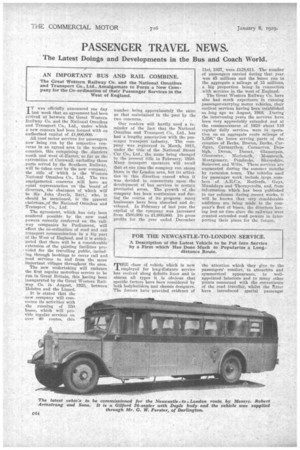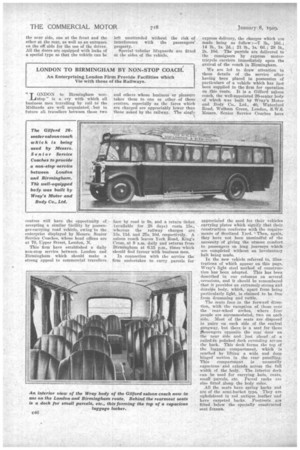FOR THE NEWCASTLE-TO-LONDON SERVICE.
Page 30

Page 31

Page 32

If you've noticed an error in this article please click here to report it so we can fix it.
A Description of the Latest Vehicle to be Put Into Service by a Firm which Has Done Much to Popularize a Longdistance Route.
MHE dass of vehicle which is now
employed for long-distance service has evolved along definite lines and in almost all types itis obvious that specific factors have been considered by both bodybuilders and chassis designers. The former have provided evidence of
the attention which they give to the passengers' comfort, to attractive and symmetrical appearance, to wellappointed interiors and to many other points concerned with the convenience of the road traveller, whilst the ttter have introduced special passenger models which are particularly suitable for operation over long distances, such chassis havine.' flexible engines and highly efficient braking, and being silent in operation and capable of high average speeds. This, in a way, suggests that there is a similarity between many of the vehicles used on long-distance work and, although this is true as a whole, it is obvious that different preferences of operators must have a decided bearing upon the equipment of vehicles and result in the introduction of special and individual features.
Support for this line of argument is to be found in the case of a Gifford saloon coach recently supplied through Mr. G. W. Forster, 10, Grange Road, dDar• lington, to Messrs. Robert Armstrong and Sons, of Ebchester, whose vehicles run under the name of Majestic Saloon Coaches. The new coach has been built for service between Newcastle and London, and its 24-seater body, which was Constructed by Duple Bodies andMotors, Ltd„ Hendon, London, N.W.9; possesses a number of striking features. One of the most interesting of these is the route indicator mounted above the windscreen, inside the vehicle, this clearly showing the chief centres which are passed en route and indicating the stops which are made when travelling north and wfien journeying in the reverse direction. One can imagine that passengers will be much attracted by this idle, for it should create added interest in the run.
The vehicle is fitted with front and rear bumper bars, those at the rear only protecting the rounded corner panels, which, as experience has proved, are the most vulnerable, the wide space between their inner ends being occupied by the hinged doors of the luggage locker in the rear panel. This locker, by
the way, is carried right forward to the front edge of the rearmost seat, which s approximately 1 ft. from the back of the body, the locker thus being of very roomy proportions. The question. of accommodating luggage has, as a matter of fact, been very carefully thought out, and, apart from the compartment at the rear, there are4ockers in the skirt of the body at the sides, whilst in the interior smaller luggage can be accommodated above the level of the back seat. The rear corner panels of the interior are equipped with shelves for carrying hats, small attach' cases, books, etc., nickelplated rods being used sothat the various articles are protected from
Another noteworthy feature for a long-distance vehicle is the elerestery type of roof, and in connection with this the day and night destination situ boxes at the front and the roar are built as an integral part of the roof and follow the shapely contour.
As we have already indicated, the body is arranged to seat 24 passengers and the seats all face in the fosvrard direction with the exception of those• over the rear wheel-arches. *Those ahead of this point are disposed on each side of a central gangway, the deep and well-sprung seats, which have individtt'ally shaped back-rests, each accommodating two people. The height of the seat beard from the ground is such that luggage can be carried below each seat. Moquette of a pleasing design is used for upholstery. The side quarters of the 'roof are finished in a plain coloured cloth 3rWch hamonizes with the general
colour scheme and the white section of the centre is relieved with polished moulding-8. There are three Airvac ventilators embodied in the raised section of the roof and these incorporate in their design electric light fittings.
The subject of lighting has received special attention and there are in all 15 interior electric lights, as well as a special step light. Ruby lights are incorporated in the back panel, these serving to indicate the extreme width of the body.
On a vehicle which is used for operation over long distances, everything must be done to guard against the extremes of temperature likely to be encountered and which affect passengers' comfort, and for this reason it has been thought desirable to provide passengers with rugs, and these are ace-emmodateti on rails on the seat backs, whilst arrangements are made for the interior to be heated by Thermorad devices. By the use of this system the heat is adjustable from zero to the maximum by means of an independent control which can be readily operated.
Louvre ventilators are used above the main lights, which can be lowered, and these carry the names of the various important towns through which the coach passes on its way from Newcastle to London. The equipment of the interior includes a series of parcel nets at the cant-rail level and draw-back curtains.
It should be Mentioned that the body has been designed to comply with the regulations of the Ministry of Transport ; that is to say, it has two deers on
the near side, one at the front and the other at the rear, as well as an entrance an the off side for the use of the driver. All the doors are equipped with locks Of a special.type so that the vehicle can be left unattended without the risk of interference with the passengers' property.
Special tubular lifeguards are fitted at the sides of the vehicle.




































